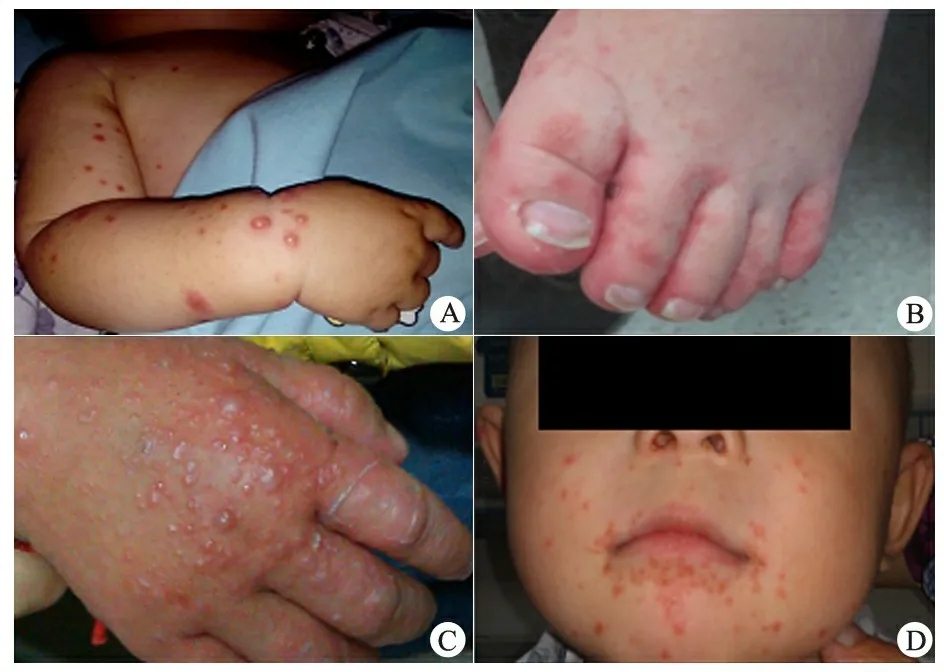柯萨奇病毒A组6型与肠道病毒71型感染所致的手足口病临床特点比较
2015-04-20刘泉波
颜 湘 刘泉波
·论著·
柯萨奇病毒A组6型与肠道病毒71型感染所致的手足口病临床特点比较
颜 湘 刘泉波

手足口病; 柯萨奇病毒A组6型; 肠道病毒71型; 脱甲; 脱屑
手足口病(HFMD)是以发热伴手、足、臀等多部位皮疹为特征的传染性疾病,其主要病原为肠道病毒71型(EV71)和柯萨奇病毒A组16型(CA16)[1,2]。但自2008年以来CA6感染所致的HFMD在世界各地报道逐渐增多[3,4],2008年在芬兰[3]首次出现了以后期脱甲为主要特征的HFMD,显示CA6为其主要的病原,之后在美国和中国[4,5]相继报道的HFMD病例中,CA6感染比例逐渐增加,成为HFMD重要的致病源。CA6感染所致的HFMD皮疹分布广泛,形态多样,难以与水痘、麻疹等疾病鉴别,临床容易漏诊和误诊,造成疾病扩散流行,带来了严重的经济和社会负担,严重危害儿童健康[5],但中国大陆尚未见关于CA6感染所致HFMD临床特点的相关报道。本研究回顾性分析重庆医科大学附属儿童医院(我院)HFMD住院患儿EV71及CA6感染病例的临床资料,比较两者临床特点和流行特征,为临床准确诊断并治疗提供依据。
1 方法
1.1 HFMD诊断标准 我院HFMD诊断参照中国卫生部制定的2010年版《手足口病诊疗指南》[6]。
1.2 研究对象的纳入标准 ①2013年9月至2014年8月在我院确诊为HFMD的住院患儿;②病原学确诊为EV71和CA6感染。
1.3 EV71和CA6检测 我院EV71和CA6检测采用广州中山达安基因试剂公司HFMD实时聚合酶链反应(RT-PCR)试剂盒,临床常规要求采集HFMD患儿的粪便、咽拭子或(和)脑脊液标本。
1.4 出院结局的判断标准 痊愈:急性感染期后所有临床症状完全消失;好转:急性感染期后临床症状逐渐消失,但未完全消失;死亡。

1.6 分组 本研究根据RT-PCR检测结果,将研究对象分为EV71组和CA6组。
1.7 资料采集 回顾性查阅病史,截取以下资料用于本文分析:①一般资料:性别、年龄;②临床资料:发病月份,临床表现(发热、神经系统受累症状),皮疹(大小、形态、部位),实验室检查(血常规、CRP、血糖和病原学结果);③出院时结局:痊愈、好转和死亡;④随访结局:并发症和后遗症。

2 结果
2.1 一般情况 研究期间共确诊HFMD住院患儿887例,其中438例(49.4%)确诊为EV71感染,包括粪便检出425例次,咽拭子检出18例次,脑脊液检出36例次,粪便及咽拭子同时检出15例次,粪便及脑脊液同时检出26例次,无3种样本同时检出病例。43例(4.8%)确诊为CA6感染,所有病例均为粪便检出。余406例中肠道病毒通用型阳性387例,CA16阳性19例。CA6组年龄6月龄至4岁,平均(17.6±8.7)月龄,<3岁42/43例(97.7%);男29例,女14例。EV71组年龄1月龄至14岁,平均(27.2±18.2)月龄,<3岁338/438例(77.2%);男275例,女163例。两组年龄差异有统计学意义(P<0.001),性别构成差异无统计学意义(P=0.546)。
2.2 发病月份 如图1所示,CA6组以1~3月冬春交季所占比例最大,分别占我院当月总HFMD的26.1%(6/23)、17.6%(3/17)和12.5%(4/32);8~10月夏秋交季分别占我院当月总HFMD的3.0%(1/33)、6.5%(5/77)和5.3%(6/114)。而EV71组以4~7月春夏交季为最高峰,分别占我院当月总HFMD的54.6%(59/108)、72.5%(100/138)和67.5%(77/114)、51.4%(53/103);10~12月秋冬交季次之,分别占我院当月总HFMD的26.3%(30/114)、40.9%(36/88)和37.5%(15/40)。
2.3 临床特点 如表1所示,发热和神经系统受累症状(呕吐、 惊跳及肢体抖动)发生率CA6组明显低于EV71组(P均<0.05),且意识障碍仅见于EV71组。CA6组重症病例1/43例(2.3%),为重型;EV71组中重症病例201/438例(45.9%),其中重型188例,危重型13例。两组重症病例所占比例差异有统计学意义(P<0.001)。CA6组住院时间明显短于EV71组(P=0.002)。

图1 2013年9月至2014年8月确诊为EV71及CA6感染所致的HFMD比例
Fig 1 Proportion of HFMD caused by CA6 and EV71 in each month from September 2013 to August 2014
Notes EV71: enterovirus 71; ca6: coxsackievirus A6; CA16: coxsackievirus A16; EV-U: universal enterovirus


ClinicalfeaturesCA6(n=43)EV71(n=438)t/χ2PHospitalization/d5.1±2.06.3±2.53.150.002SymptomsFever34(79.1)422(96.3)23.72<0.001Cough16(37.2)147(33.6)0.230.630Rhinorrhea8(18.6)101(23.1)0.440.506Salivation27(62.8)280(63.9)0.020.882Diarrhea6(14.0)56(12.8)0.050.827Poororalintake34(79.1)292(66.7)2.760.097Vomiting7(16.3)174(39.7)9.170.002Startleresponse2(4.7)258(58.9)46.40<0.001Febrileseizure3(7.0)16(3.7)1.140.236Alteredconscious-ness012(2.7)1.210.613Limbtrembling1(2.3)66(15.1)5.300.021Unsteadygait2(4.7)68(15.5)3.720.054RashesdistributionPalm/soles41(95.3)420(95.9)0.030.697Perioralareal14(32.6)0146.88<0.001Oralulcer27(62.8)315(71.9)1.590.208Trunks30(69.8)11(2.5)227.15<0.001Buttocks23(53.5)292(66.7)3.010.083Limbs30(69.8)36(8.2)125.29<0.001Externalia4(9.3)5(1.1)14.200.005RashesmorphologyMaculopapule28(65.1)410(93.6)39.04<0.001Vesicle23(53.5)49(11.2)55.05<0.001Bulla3(7.0)030.750.001LaboratorydataWBC/×109·L-111.7±5.111.1±4.10.810.419WBC>10×109 ·L-123(53.5)238(54.3)0.010.915CRP>8mg·L-116(37.2)317(72.4)26.26<0.001GLU/mmol·L-16.8±3.85.6±2.01.950.057GLU>6.11mmol ·L-114(32.6)101(23.1)0.420.515
2.4 皮疹 两组患儿均出现皮疹,CA6组皮疹除分布于手足(95.3%)、口腔(62.8%)、臀部(53.5%)等部位,也见于躯干(69.8%)(图2A)、四肢(69.8%) (图2A~C) 、 口周(32.6%)(图2D)和外生殖器(9.3%);而EV71组皮疹主要局限于手和(或)足(95.9%)、口腔(71.9%)、臀(66.7%)等部位。就形态而言,CA6组斑丘疹28例(65.1%),疱疹23例(53.5%),大疱疹3例(7.0%),腐蚀样皮疹1例(2.3%),斑丘疹及疱疹同时出现11例(25.6%);而EV71组皮疹较CA6组细小,斑丘疹410例(93.6%),大多呈针帽大小,疱疹49例(11.2%),斑丘疹及疱疹同时出现35例(8.0%)。两组皮疹形态为斑丘疹和疱疹的比例差异均有统计学意义(P均<0.001)(表1)。

图2 CA6相关性HFMD的皮疹表现
Fig 2Characteristics of rashes in children with HFMD caused by CA6
NotesA:maculopapule and bulla were mainly distributed in upper limbs and trunks;B:erosions were noted in foot;C:bullae were found on the hand;D:maculopapule were mainly distributed in the perioral area
2.5 实验室检查 CA6组中WBC增多23例(53.5%);CRP增高16例(37.2%),最高达51 mg·L-1;血糖升高14例(32.6%),与EV71组相比,WBC和血糖均值两组相近,且WBC增多与血糖升高的发生率两组差异亦无统计学意义(P均>0.05),而CA6组CRP增高的发生率低于EV71组(P<0.001)(表1)。
2.6 随访 CA6组43例患儿均痊愈,均完成来院随访;EV71组428例(97.7%)出院时痊愈,1例(0.2%)死亡,347/437例(79.4%)完成来院随访。
2.6.1 并发症 随访至HFMD急性感染期后8周,脱甲发生率在CA6组(10/43,23.3%)明显高于EV71组(5/347,1.4%),差异有统计学意义(P<0.001)。两组脱甲发生于急性感染期后2~8周,CA6组脱甲时间主要集中于急性感染期后第5周(3/10,30.0%),EV71组主要发生于急性感染期后第4周(2/5,40.0%)。脱屑发生率CA6组(12/43,27.9%)明显高于EV71组(15/347,4.3%),差异有统计学意义(P<0.001)。两组脱屑发生于急性感染期后1~8周,在CA6组和EV71组均集中发生于急性感染期后第4周,分别占33.3%(4/12)和46.7%(7/15)。

3 讨论
本研究比较EV71和CA6感染所致HFMD的临床特点和流行特征,结果显示CA6组感染所致的HFMD发病高峰较EV71组有所提前,发病高峰主要为冬春交季和夏秋交季,与中国长春地区[7]CA6病原引起的HFMD主要集中在夏季并不一致。本研究EV71组发病高峰以春夏交季和秋冬交季多见,这与中国香港及新加坡等地[8,9]报道EV71流行季节类似。CA6和EV71感染发病高峰时间的差异是源于生物学特性不同,还是由遗传表型所致,值得进一步研究。这也提示在重庆地区除了在EV71好发季节重点防控HFMD外,同时也应该对CA6发病高峰时间段提高警惕,防止引起局部或大规模流行。
本研究EV71和CA6组患儿年龄均集中在3岁以内,但CA6组患儿年龄明显小于EV71组,这与泰国地区[10]报道的CA6感染患儿1岁内多见一致,然而CA6组患儿年龄较EV71组小的原因是否与CA6病原毒力的特殊属性或变异有关尚未得知,但提示CA6感染所致的HFMD与小年龄患儿密切相关,应提醒临床医生应对小年龄儿童进行重点预防和监控。
本研究CA6组患儿较EV71组皮疹广泛、皮损严重、形态多样,皮疹累及口周、躯干和四肢等部位,且疱疹多见甚至出现大疱疹、腐蚀性皮疹等特殊皮疹表现,这与芬兰[3]、美国[4]等地报道类似,CA6感染所致的HFMD皮疹难以与水痘、脓疱病、麻疹等相鉴别。而EV71组患儿的皮疹主要局限于手足等肢体末端位置,皮疹细小,以斑丘疹为主。且有报道[11]CA6感染所致的HFMD与口周皮疹存在密切关系,本研究也支持这一观点,本文口周皮疹仅见于CA6感染。提示对于疑诊HFMD并存在口周皮疹的患儿,可能是由CA6病原感染引起,必要时可完善粪便等分子病原学检测进一步明确。

本研究随访发现EV71和CA6组均出现了后期并发症(脱甲及脱屑),但CA6组脱甲和脱屑的发生率明显高于EV71组,这与中国台湾地区报道[13]类似,说明HFMD中多种病原可引起脱甲和脱屑,但仍以CA6感染为主。本研究脱甲、脱屑主要发生于HFMD急性感染期后4~5周,这与Österback等[3]报道的脱甲、脱屑发生在HFMD急性感染后1~2个月和Guimbao等[14]报道脱甲、脱屑平均发生在HFMD急性感染期后40 d基本一致,然而目前对于脱甲的机制尚不明确,有研究者提出与大量病毒复制导致甲基质的破坏有关[3],但仍需要更多实验进一步探讨。
[1]Solomon T, Lewthwaite P, Perera D, et al. Virology, epidemiology, pathogenesis, and control of enterovirus 71. Lancet Infect Dis, 2010, 10(11):778-790
[2]He SJ, Han JF, Ding XX, et al. Characterization of enterovirus 71 and coxsackievirus A16 isolated in hand, foot, and mouth disease patients in Guangdong, 2010. Int J Infect Dis, 2013, 17(11):e1025-1030
[3]Österback R, Vuorinen T, Linna M, et al. Coxsackievirus A6 and hand, foot, and mouth disease, Finland. Emerg Infect Dis, 2009, 15(9):1485-1488
[4]Mathes EF, Oza V, Frieden IJ, et al. "Eczema coxsackium" and unusual cutaneous findings in an enterovirus outbreak. Pediatrics, 2013, 132(1): e149-157
[5]Xing W, Liao Q, Viboud C, et al. Hand, foot, and mouth disease in China, 2008-12: an epidemiological study. Lancet Infect Dis, 2014, 14(4):308-318
[6]卫生部办公厅.手足口病诊疗指南(2010年版). http://www.moh.gov.cn/yzygj/s3593g/201306/6d935c0f43cd4a1fb46f8f71acf8e245.shtml
[7]Han JF, Xu S, Zhang Y, et al. Hand, foot, and mouth disease outbreak caused by coxsackievirus A6, China, 2013. J Infect, 2014, 69(3):303-305
[8]Ma E, Lam T, Chan KC, et al. Changing epidemiology of hand, foot, and mouth disease in Hong Kong, 2001-2009. Jpn J Infect Dis, 2010, 63(6): 422-426
[9]Ang LW, Koh BK, Chan KP, et al. Epidemiology and control of hand, foot and mouth disease in Singapore. Ann Acad Med Singapore, 2009, 38(2):106-112
[10]Puenpa J, Chieochansin T, Linsuwanon P, et al. Hand, foot, and mouth disease caused by coxsackievirus A6, Thailand, 2012. Emerg Infect Dis, 2013, 19(4):641-643
[11]Centers for Disease Control and Prevention (CDC. Notes from the field: severe hand, foot, and mouth disease associated with coxsackievirus A6-Alabama, Connecticut, California, and Nevada, November 2011-February 2012. MMWR. Morbidity and mortality weekly report, 2012, 61(12): 213
[12]Pérez-Vélez CM, Anderson MS, Robinson CC, et al. Outbreak of neurologic enterovirus type 71 disease: a diagnostic challenge. Clin Infect Dis, 2007, 45(8):950-957
[13]Wei SH, Huang YP, Liu MC, et al. An outbreak of coxsackievirus A6 hand, foot, and mouth disease associated with onychomadesis in Taiwan, 2010. BMC Infect Dis, 2011, 11:346
[14]Guimbao J, Rodrigo P, Alberto MJ, et al. Onychomadesis outbreak linked to hand, foot, and mouth disease, Spain, July 2008. Euro Surveill, 2010, 15(37). pii: 19663
(本文编辑:张萍)
Comparison of clinical features of hand, foot, and mouth disease caused by coxsackievirus A6 and enterovirus 71
YANXiang,LIUQuan-bo
(DepartmentofInfectiousDisease,Children′sHospitalofChongqingMedicalUniversity,MinistryofEducationKeyLaboratoryofChildDevelopmentandDisorders,ChongqingKeyLaboratoryofPediatrics,Chongqing410014,China)
LIU Quan-bo,E-mail:liuqb1223@sina.com
ObjectiveTo investigate the difference of clinical features of hand, foot, and mouth disease (HFMD) caused by coxsackievirus A6 (CA6) and enterovirus 71 (EV71).MethodsInpatients with HFMD admitted to Children′s Hospital of Chongqing Medical University from September 2013 to August 2014 were collected. Complications and sequelae were investigated by follow-up interviews.ResultsA total of 887 inpatients with HFMD including 438 cases in EV71 group and 43 cases in CA6 group were recruited. There were different peaks in two groups: the largest proportion from January to March in CA6 group and the significant peak from April to July in EV71 group. The age of patients in the CA6 group was younger than that of EV71 group,(17.6±8.7) monthsvs(27.2±18.2) months,P<0.05. The rate of fever and manifestations of neurologic involvement including vomiting (16.3%), startle response (4.7%) and limb trembling (2.3%) were significantly lower in CA6 group than in EV71 group (allP<0.05). The distribution of rashes involving trunks (69.8%), limbs (69.8%), perioral area (32.6%) and externalia (9.3%) and the morphology of rashes as vesicle (53.5%) were significantly associated with that in CA6 group (allP<0.05). All the children in CA6 group recovered smoothly and received follow-up interviews after therapy successfully . While 428 children(97.7%) were recovered and 1 child(0.2%) was dead in EV71 group. And only 347 cases (79.4%) completed the interviews in EV71 group. The rate of onychomadesis and desquamation was significantly higher in CA6 group (allP<0.05). All the children in CA6 group showed total recovery without any sequela, however 8 children suffered from paralysis and 1 child had epilepsy with EV71 infection. ConclusionThe occurrence of HFMD had different seasonal distribution between two groups. Compared with those infected by EV71, the children with CA6 infection were younger. And the patients in CA6 group presented with widespread distribution and various morphology of rashes, had fewer manifestations of neurologic involvement and a relatively better prognosis. Moreover, it had higher rate of onychomadesis and desquamation .
Hand-foot-mouth disease; Coxsackievirus A6; Enterovirus 71; Onychomadesis; Desquamation
渝科发计字[2012]27号-cstc2012jjA10084
重庆医科大学附属儿童医院感染科,儿童发育疾病研究教育部重点实验室,儿科学重庆市重点实验室 重庆,410014
刘泉波,E-mail:liuqb1223@sina.com
10.3969/j.issn.1673-5501.2015.03.010
2015-01-22
2015-05-20)
